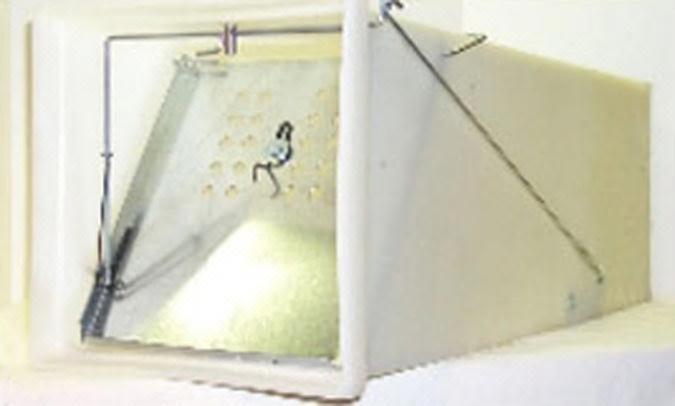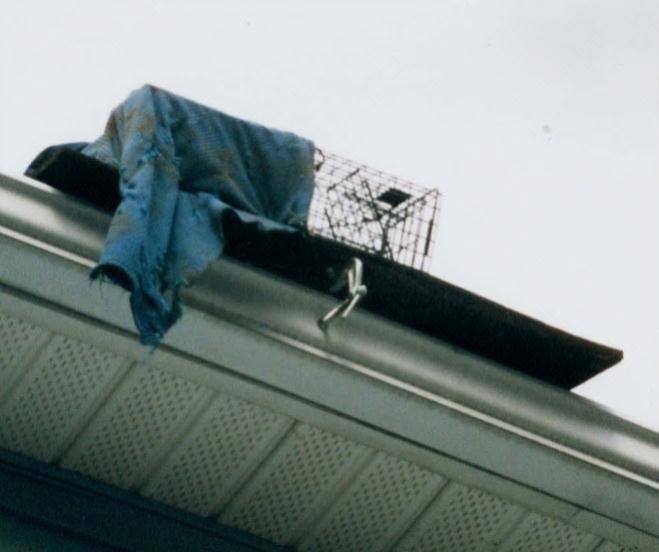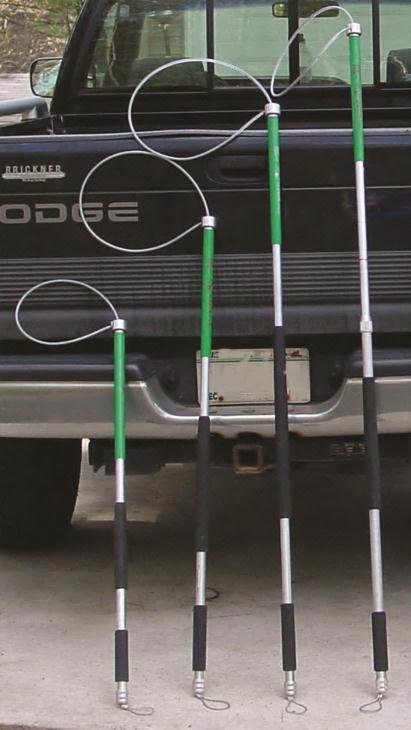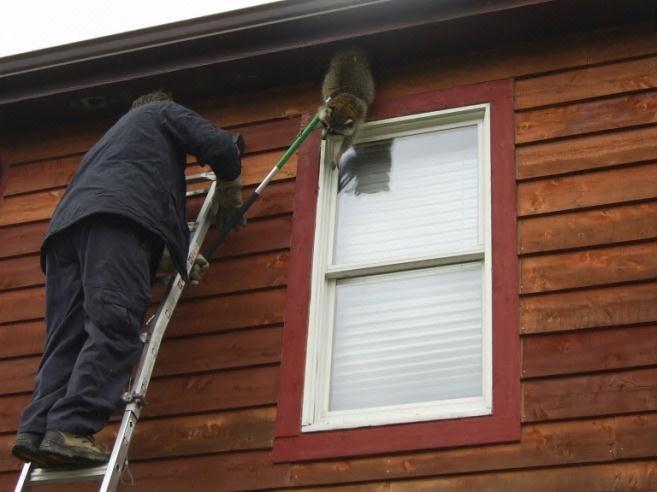In this Module…
Learning Objectives
Terms to Know
Preparation
Strategies to Reduce Stress
Handling Snakes
Animal Removal
Animal Disposition
Study Questions for Animal Handling
Learning Objectives
- Describe the principles of proper animal handling.
- Be able to apply appropriate animal handling principles to specific situations.
- Define relocation and translocation.
- Identify 3 tools used in animal handling.
Terms to Know
Animal handling The treatment of wildlife while under the direct control of a person.
Direct capture The technique of obtaining control of an animal without the use of traps.
Containment – Controlling the animal once you have captured it.
Animal handling requires skill, competence, knowledge of risks and diseases, and respect for the humane treatment of the animal you are handling. It is important to protect yourself, the animal you are handling, have a clear understanding of the law, and a plan for the final disposition of the animal. If you plan to euthanize the animal, you should take steps to ensure that your dispatch method is in sync with your capture and transport methods.
Preparation
 Figure 1. Animal handling tools (top to bottom): raccoon-sized trap, welding gloves, landing net, small animal grabber, catch pole, medium animal grabber, bag to set trap on to catch debris. Photo by ALL OUT Wildlife Control, LLC.
Figure 1. Animal handling tools (top to bottom): raccoon-sized trap, welding gloves, landing net, small animal grabber, catch pole, medium animal grabber, bag to set trap on to catch debris. Photo by ALL OUT Wildlife Control, LLC.
Animals can become stressed when captured, approached, and handled by humans. Proper animal handling begins before the animal is captured.
- Animal handling equipment should be professional grade and in proper working order. Suggested equipment includes
- durable heavy leather gloves (such as welding gloves),
- catch pole with quick release,
- blanket made of smooth but durable fabric (such as denim),
- cat grasper,
- hand landing net (fishing), and
- snake tongs (Figure 1).
- Select the correct tools for the job. For example, use the smallest trap that is necessary to capture the target animal. Small traps reduce injuries to an animal because the animal is more restrained.
- Minimize unnecessary contact to reduce stress to the animal. Temporarily cover holding and transportation cages with a blanket or tarp to protect the animal from weather and to provide a sense of security to the animal. In addition, a cover offers another layer of protection to the WCO during handling and transport.
Strategies to Reduce Stress
Traps are stressful to animals. Place traps in locations that reduce exposure of trapped animals to humans, pets, and severe weather conditions. For example, a cage trap set in bushes may be an effective site to capture the animal while providing it with protection from the hot sun. Box traps (Figure 2) provide animals with protection against winter weather.
Strategies to Reduce Stress
- Place traps in locations that reduce exposure of trapped animals to humans, pets, and severe weather conditions. For example, a cage trap set in bushes may be an effective site to capture the animal while providing it with protection from the hot sun. Box traps (Figure 2) provide animals with protection against winter weather.

- Select cage traps with fine mesh, such as ½- x 1-inch, to reduce the likelihood of injury. A trap with 1- x 1-inch mesh often causes animals such as squirrels to suffer nose-burn, the loss of fur on the bridge of the nose due to repeatedly pushing its nose through the wire mesh.
- Cage traps should be set with 50% of the trap surface covered (Figure 3). Trap covers are commercially available or can be made from corrugated plastic. Sturdy blankets and cardboard also provide useful covers. Cover traps to:
- provide the animal with shelter from wind, rain, sun, and predators;
- provide you with a blind zone to approach a trapped animal; and
- reduce client anxiety over seeing a trapped animal. An animal that is out of sight is out of mind.

Photo by Stephen M. Vantassel.
- Ensure that traps are properly staked or secured to prevent them from rolling over and to reduce the likelihood of removal by people or other animals.
- Keep good records that allow others to check traps for you in the event of an illness or unforeseen event that prevents you from checking traps. New York requires traps to be checked at least once per day. Some NWCOs ask their clients to routinely check traps and report their findings to the NWCO. This process is unreliable and undependable; it may result in traps not being checked as required. The responsibility for checking traps and for the animal’s welfare are yours and yours alone.
- Equip cage and box traps with water bottles and food for animals that are trapped. Check traps daily to ensure that they always contain fresh food and water.
- Use kill traps or lethal sets when circumstances are appropriate and the law allows. When used appropriately, lethal traps and sets may be less stressful to animals than alternative control techniques.
- Keep external noise and excessive handling or movement of traps to a minimum. Wild animals, particularly prey species, often perceive noise and excessive movement as threats.
- Handle animals as briefly as possible. Animals often become stressed when near humans, so reduce the amount of time spent in hand. Do not allow animals to be used for show and tell to neighbors and friends.
Handling Snakes
In New York, it is illegal for anyone, including NWCOs, to handle native snakes.
Animal Removal
Catch Poles
Catch poles (Figure 4), also known as snare, noose, or restraint poles, should be high quality with an instant open feature that immediately loosens the noose when activated. While it is important to ensure the animal remains firmly under control, cinching a noose around the neck or chest of an animal could kill the animal. Always treat animals with respect and have concern for their stress and suffering.
Have a cage trap ready before you use a catch pole to minimize the time the animal remains in the noose. Cage or box traps with spring-loaded doors are convenient, as you can set them in the upright position to allow for easy insertion of a noosed animal. When the animal is inside, close the door, immediately release the noose, and remove the pole. It takes coordination, but with practice you will be able to do this.

Photo by Tomahawk Live Trap Co.
Hand Nets
Hand nets, also known as landing nets, simplify animal capture by making it unnecessary to place a noose around the head of an animal. Choose a size that will fit diagonally into a raccoon-sized cage or box trap. This allows you to release the animal by simply inserting the animal, net and all, into the trap. Most animals will get out of the net by themselves. Monitor the animal out of public view as it escapes the net, being sure to remove the net and close the trap door completely after the animal is free from the net.
Loose Animals
One of the most challenging situations during WDM is the capture and removal of an animal that is loose in a room. It may be a difficult task and you often have to do it in view of the client. If possible, do not have clients in the area where you are working, for the safety of both you and the client. Animals are unpredictable and the presence of additional people creates greater anxiety for all.
Some tips for catching a loose animal:
- Limit the movement of the animal by closing gates, doors, windows, and other openings.
- Determine if the animal must be captured immediately or if setting traps may be appropriate.
- Wear heavy leather gloves to protect yourself from scratches and bites, and to provide protection from diseases and parasites.
- Prepare for the worst. An animal caught in a catch pole may urinate and defecate. Place a large piece of cardboard under an upright trap to catch this debris. Prepare clients with what to expect.
- Ask whether anyone might have had contact with the animal. If so, rabies testing or treatment may be required.
Raccoons
Catch poles, cat graspers, and hand nets are ideal tools for capturing raccoons. When cornered, a raccoon may hide its head and make itself difficult to capture with a catch pole. When this happens, gently poke the raccoon in the ribs and slip the noose around its head when it looks up in response. Raccoons are very strong and limber, so try to get the loop around the chest to avoid an escape (Figure 5).

Opossums
Opossums are easily captured with a cat grasper or hand net.
Skunks
Use covered cage traps or box traps to capture skunks.
Squirrels
Use snake tongs or a hand net to capture squirrels.
Trapped Animals
Move captured animals to your vehicle or otherwise out of public view as quickly as possible. This will reduce stress to the animal and minimize the risk of injury to well-meaning or curious onlookers. Ensure that the holding area for the animals is neither too hot (out of direct sun) nor too cold (out of rain, snow, or wind). In general, small mammals have a low tolerance to extreme heat or cold, while large animals (raccoon and larger) have greater tolerance. Minimize temperature extremes for all of the animals you manage. Sometimes, moving the traps and animals to a shaded area or out of the elements is sufficient. Always keep cages partially covered to help reduce animal stress.
Animal Disposition
Depending on the species, five choices are available for disposition of problem animals: on-site release, relocation, translocation, transport to a licensed wildlife rehabilitator, or euthanasia.
Moving wildlife is illegal in New York, however licensed NWCOs may move most species of wildlife. Snakes cannot be moved. Coyotes cannot be relocated without authorization from the DEC Regional Wildlife Manager. Rabies vector species (bats, raccoons, and skunks) cannot be moved without first consulting the county health department. You must have written permission of the landowner where the animal will be released. This applies to both private land and public land.
On-site Release
On-site release is the easiest and usually most convenient option. Open the trap and release the animal on the property where you caught it. Use caution when releasing animals to minimize injury to you and the animals. The following are some tips to help an on-site release go smoothly:
- Consult with the landowner and obtain written permission in advance of release.
- Without handling the animal, inspect it to ensure it is free of debilitating injuries or signs of illness. Only release animals that appear healthy enough to survive.
- Ensure that structures are properly secured. Skunks tend to walk into open garages.
- Children and pets should be kept from the area. Although it is unlikely that the animal will turn and attack, it is possible.
- Whenever possible, release the animal towards cover and away from roads and people.
- Nocturnal animals should be released at dusk and diurnal animals in the morning.
Relocation and Translocation
Relocation refers to moving and releasing an animal off the property where it was captured but within its home range. This is usually a short distance away from where it was captured. Some people think of relocation as on-site release
Translocation refers to moving and releasing an animal a greater distance from where it was captured. Translocated animals are no longer within their home range. Many people think of translocation as relocation.
If an animal must be moved, it should be moved as short a distance as possible. For the best chance of survival, the animal should be released within its home range.
Research has demonstrated that relocated and translocated animals suffer higher-than-normal rates of mortality, are more likely to repeat problem behaviors, and pose a risk of transmitting diseases.
Translocation is stressful and may be inhumane to released animals. When species such as raccoons and tree squirrels are released into an area where territories already are occupied, resulting disputes can lead to injury and death to both released and resident animals.
If moving the animal away from its habitat is the chosen and legal option for disposition, consider the following recommendations:
- NWCO permit conditions require NWCOs to have written permission of the landowner where the animal will be released in advance of release.
- Without handling the animal, inspect it to ensure that it is free of debilitating injuries or signs of illness. Only release animals that appear healthy enough to survive.
- Release the animal in accordance to state laws, in habitat suitable for the species.
- Release species that are more communal and less territorial, such as rabbits, voles, opossums, and birds.
- Release the animal at a time that will provide the greatest opportunity for survival, especially in respect to diurnal and nocturnal activity.
- Release the animal a sufficient distance from the capture location to minimize returns. Use natural barriers (rivers) and human barriers (highways) to reduce wildlife return.
The following are suggested minimum distances:
- chipmunk-sized animals (2 miles),
- skunks and opossums (10 miles), and
- raccoons (20 miles).
Transport to a Wildlife Rehabilitator
In New York, only injured, orphaned, or diseased wildlife should be transported to licensed wildlife rehabilitators. Do not bring healthy nuisance animals to rehabilitators, as this is a violation of both yours and the rehabilitator’s permit conditions. Always contact the rehabilitator in advance of transport, to make sure they are willing and capable of caring for the animal.
Euthanasia
If the potential for disease transmission is significant (many animals are rabies vector species and should not be moved), euthanasia may be the preferred option. Euthanasia, if required or necessary, must be performed in accordance with state laws. Guidelines for euthanasia have been established by the American Veterinary Medical Association (AVMA) but their application in field settings may be difficult. When euthanasia, as defined by AVMA, is not possible due to logistical constraints, animals must be killed in the most humane way possible (humane dispatch). Recommendations are available at http://icwdm.com. In addition, organizations such as the National Wildlife Control Operators Association and The Wildlife Society are working on guidelines for euthanasia in field settings.
Module 10 contains more information on euthanasia.
Acknowledgments
Original document reviewed by
- Eddie Hope, Virginia Professional Wildlife Removal Services, LLC;
- Bahar S. Baviskar, Society for Wildlife Conservation, Education and Research.